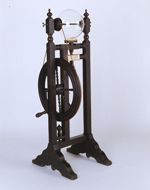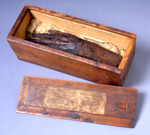Art & Artifacts
Discover the Library Company's Art and Artifact Collection
A Cabinet of Curiosities
The concept of a “Cabinet of Curiosities” dates to the 16th and 17th centuries and was a precursor to the modern museum. Beginning in the Renaissance, many intellectuals and state figures collected rare objects ranging from bones and minerals to manuscripts and art objects, which would be displayed in rooms and galleries known as Wunderkammer or wonder rooms. The galleries acted as displays of contemporary knowledge, as well as a demonstration of dedication to the pursuit of science and history. These collections, while largely disorganized and lacking the focus of museums as we know them today, were important repositories of artifacts and natural phenomena. The Library Company was part of this tradition for many years, housing and displaying various objects ranging from fossils and snake skins to Roman coins and preserved human hearts. While many of these artifacts were thrown out, sold, or lost over time, some still remain as examples of the Library Company’s days as America’s first museum.

Cuneiform Tablet, ca. 2044 B.C.
Clay.
1 1/2" x 1 3/4" x 1 3/4".
Library Company of Philadelphia. Gift of Miss Mary McClellan, 1929.
This tablet is written in cuneiform, one of the oldest forms of written language known. It was developed and used by the Sumerian civilization of the Euphrates region and went through several evolutions before the form we see here. It was made by pressing a reed, called a stylus, into clay to create the triangular depressions. The tablet was then baked and, in this case, enclosed in another baked clay envelope for delivery. What we see here is the sealed envelope, and inside of it there is another tablet. The tablet was made at the archives of Lagash in Ur, which is modern day Iraq, and records the loan of 22 small boatloads of barley from the royal granary at Lagash to two unnamed men, who probably would have used the grain for spring planting.
Designed by Benjamin Franklin.
Electrical Machine, ca.1742-1747.
Walnut, glass, iron and leather.
59" x 28" x 24"
Library Company of Philadelphia, Gift of Benjamin Franklin Bache, 1792.
This electrical apparatus documents Benjamin Franklin’s experiments in electricity and the Library Company’s early role as a scientific institution. In the 1740s and 1750s, Franklin conducted many experiments in electricity which led to the discovery of positive and negative charges, the classification of lightning as an electrical phenomenon, and the development of the lightning rod. The Electrical Machine is a static energy generator that works by rubbing the leather pad against the spinning glass globe to produce a static electrical charge in the globe. Franklin did not patent his discoveries or many inventions, and his philanthropy is obvious in his description of his civic duty: “we enjoy great advantages from the inventions of others, we should be glad of an opportunity to serve others by any invention of ours; and this we should do freely and generously.[1]”
Mummy’s Hand.
4" x 12" x 5".
Library Company of Philadelphia, Gift of Benjamin West, 1767.
In 1767, artist Benjamin West (1738-1820) sent a gift, which was carried from London to Philadelphia by Library Company secretary Francis Hopkinson (1737-1791): an amputated, mummified hand. The Directors' Minutes record that it joined a number of other objects, including fossils, animal skins, and minerals, held in the Library. Most of these pieces had been removed from the collection in the nineteenth century. West, a Pennsylvanian, continued to be a close friend to Benjamin Franklin and the Library Company even though he remained a resident of London for the rest of his life. During the 18th century, mummies were considered a premium item in a "cabinet of curiosity." Painters also valued them as an ingredient in a glaze known as "mummy brown," which West is known to have used. The pigment was available up until the mid-20th century after a steep decline in use earlier in the century because of ethical, anthropological, and cultural reasons.
The Library Company acknowledges that in the past it regarded the mummified hand as a curiosity, which is harmful and offensive. The Library Company aims to correct this by showing dignity and respect to the remains of a once living person.

